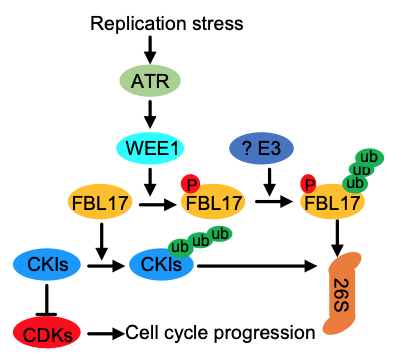华中农业大学继续教育培训
 咨询电话:
咨询电话:400-0815-589
欢迎来到继续教育培训网院校库!
继续教育培训网首页 咨询电话:
咨询电话:近日,我校生命科学技术学院严顺平教授团队揭示了蛋白激酶WEE1通过抑制E3泛素连接酶调控DNA复制胁迫应答的新机制,研究对利用WEE1抑制剂治疗癌症具有一定指导意义。
DNA复制胁迫严重影响基因组的稳定性,是癌细胞的特点之一,也是癌症治疗的重要靶标。在癌细胞中,WEE1会大量表达;而WEE1功能缺失会导致细胞死亡。因此,WEE1抑制剂已被用于治疗癌症,正在进行二期临床实验。以前的研究发现,WEE1通过磷酸化细胞周期的主要驱动蛋白CDK直接抑制CDK,从而阻止细胞周期进程。但是,在拟南芥中的研究表明,这种直接抑制机制在植物中并不保守。
本研究通过正向遗传学手段发现突变E3泛素连接酶FBL17能够抑制wee1突变体对DNA复制胁迫的超敏感性。进一步的生化实验表明,WEE1可以磷酸化FBL17并且促进FBL17的降解。而FBL17本身可以通过促进CDK的抑制蛋白(CKI)的降解来激活CDK。因此,WEE1通过调控FBL17和CKI间接地抑制CDK。有意思的是,他们发现人的WEE1也可以通过磷酸化来抑制FBL17的同功能蛋白SKP2,表明这一机制在动物中是保守的。

WEE1-FBL17-CKI-CDK分子模块调控复制胁迫的工作模型
该研究发现了WEE1的新底物,完善了植物的WEE1信号通路,加深了对复制胁迫应答机制的认识。该研究表明,有些癌细胞可能通过改变WEE1下游的蛋白来逃逸WEE1抑制剂,因此,该研究对于利用WEE1抑制剂治疗癌症具有一定指导意义。该研究起始于模式植物拟南芥,最终发现了一个在动物和植物中保守的细胞周期调机制,这也进一步说明了模式植物研究的重要性和优越性。
英文摘要:DNA replication stress poses a severe threat to genome stability and is a hallmark of cancer as well as a target for cancer therapy. It is well known that the evolutionarily conserved protein kinase WEE1 regulates replication stress responses by directly phosphorylating and inhibiting the major cell cycle driver CDKs in many organisms. Here, we report a novel WEE1 pathway. We found that Arabidopsis WEE1 directly interacts with and phosphorylates the E3 ubiquitin ligase FBL17 that promotes the degradation of CDK inhibitors. The phosphorylated FBL17 is further polyubiquitinated and degraded, thereby leading to the accumulation of CDK inhibitors and the inhibition of CDKs. In strong support for this model, either loss of function of FBL17 or overexpression of CDK inhibitors suppresses the hypersensitivity of the wee1 mutant to replication stress. Intriguingly, human WEE1 also phosphorylates and destabilizes the FBL17 equivalent protein SKP2, indicating that this is a conserved mechanism. This study reveals that the WEE1-FBL17/SKP2-CKIs-CDKs axis is a molecular framework for replication stress responses, which may have clinical implications because the WEE1 inhibitor AZD1775 is currently in phase II clinical trial as an anticancer drug.
